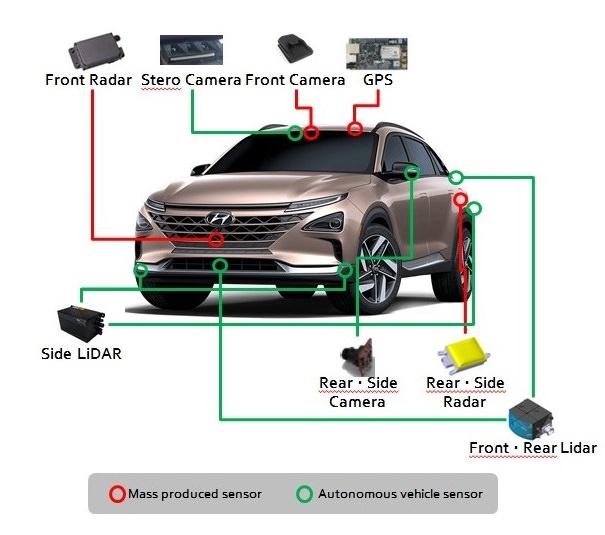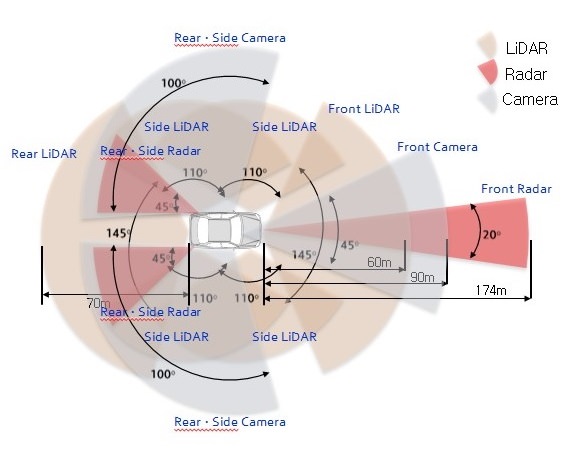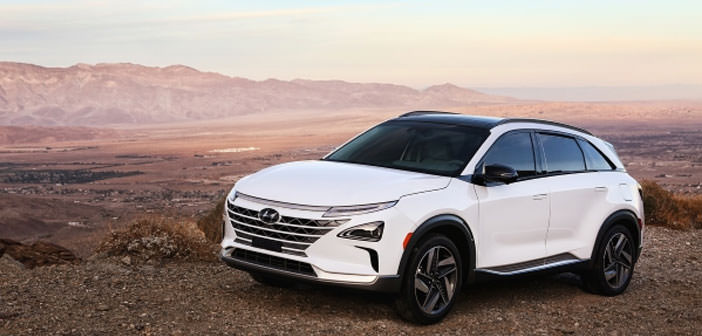Hyundai Nexo with hydrogen fuel cell power: How it works
A fleet of five self-driving vehicles recently traveled 190 kilometers from Seoul to Pyeongchang: Hyundai now publishes a few more details on how they work.
Hyundai has recently demonstrated its level 4 self-driving capabilities of its latest prototypes covering 190 km from Seoul to Pyeongchang at around 100/110 km/h. It was a fleet of five cars, including three Hyundai Nexo fueled hydrogen fuel cells and two Genesis G80s. All vehicles were able to complete the route independently without human intervention.
The initiative is part of the Hyundai project which provides for the marketing of self-employed vehicles of level 4 by 2021 and completely autonomous (level 5) by 2030. On the other hand, these objectives are still far from being achieved and this is demonstrated by the fact that Hyundai has carried out this test on motorways and not on urban arteries.
The fuel-cell Nexo SUV will be introduced to the Korean market in the next month. The vehicles at the base of the test used 5G connection technology and had two buttons on board: Cruise and Set which, when pressed, enabled autonomous driving on vehicles. When the five vehicles entered the highway, they began to behave naturally with respect to the rest of the traffic, performing lane changes when needed, as well as overtaking and slowing maneuvers compared to toll booths. The payment in these cases was made via the system in use in South Korea Hi-Pass. The test started on February 2nd from Seoul and went on for 190 kilometers.
The vehicles were equipped with a series of advanced technologies, previously shown by Hyundai at the CES in Las Vegas at the beginning of the year. These allowed them to detect the movements of the other cars and make correct decisions at intersections and branches, as well as appropriately slow down according to the width available in conjunction with the toll booths and precisely identify the position of the vehicle on the map even in those circumstances in which the GPS signal was absent, as in the tunnels.
Before carrying out the test, Hyundai tested its vehicles on the motorways for hundreds of thousands of kilometers, collecting a considerable amount of data on possible obstacles in order to carry out the test in total safety.
 The interior and exterior of the test vehicles are very similar to those of other Hyundai commercial vehicles, but there are several LIDAR cameras and systems. The processes underpinning autonomous driving require the processing of a large volume of data and entail a considerable consumption of electrical resources. The fuel-cell system adheres well to this need because it is able to produce electricity through a reaction between hydrogen and oxygen in the fuel cell.
The interior and exterior of the test vehicles are very similar to those of other Hyundai commercial vehicles, but there are several LIDAR cameras and systems. The processes underpinning autonomous driving require the processing of a large volume of data and entail a considerable consumption of electrical resources. The fuel-cell system adheres well to this need because it is able to produce electricity through a reaction between hydrogen and oxygen in the fuel cell.
 Nexo can travel more than 600 kilometers on a single charge, which is completed in about five minutes. It also boasts an equivalent life to internal-combustion vehicles and a load capacity of 839 liters. Furthermore, on the 5G network provided by KT Corp, five different IT services are managed, grouped through an intuitive user interface that is accessible to any type of user.
Nexo can travel more than 600 kilometers on a single charge, which is completed in about five minutes. It also boasts an equivalent life to internal-combustion vehicles and a load capacity of 839 liters. Furthermore, on the 5G network provided by KT Corp, five different IT services are managed, grouped through an intuitive user interface that is accessible to any type of user.
Passengers sitting in the back can access ” Home Connect “, a car-to-home technology that allows users to control the IoT devices installed in their smart homes. They can view images from surveillance systems in real time, adjust lighting, manage doors or TV, as well as the home energy system. These technologies will be included in Hyundai vehicles starting from the first half of 2018 for home-to-car and from 2019 for car-to-home.
” Assistant Chat “, on the other hand, allows users to communicate with a Chat Bot through simple voice commands and to receive answers in the form of images or texts. ” Wellness Care “, on the other hand, keeps track of the health conditions of passengers on the back of the vehicle, such as their stress level, heart rate and mood. Passengers can also access relaxing treatment services and can interface with a health advisor through a real-time video call.
The vehicle is also equipped with external noise suppression technology and ” Mood Care “, which regulates interior lighting and music based on data from the ” Wellness Care ” module. ” Everysing “, on the other hand, is a karaoke application, which allows passengers to sing according to the music played on longer journeys. On the back seats, you can send video broadcasts and view traffic information in several languages, including English, Korean and Chinese.
These are advanced infotainment features designed to make the car journey as comfortable and relaxing as possible, set up by Hyundai along with its technical partners. These include Aurora Innovation as regards the autonomous driving part, as revealed at the CES.
Future Hyundai vehicles will also be equipped with V2X communication technologies, or ” Vehicle-to-everything “. These represent a crucial component for autonomous driving because they manage the communications between vehicle and other devices, vehicles, pedestrians equipped with smartphones and the electricity grid. This information is then used to avoid accidents and to optimize navigation. To this end, Hyundai is a founding member of the American Center for Mobility, a research institute for future mobility, on which it has invested 5 million dollars.

